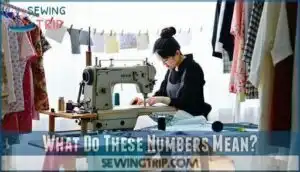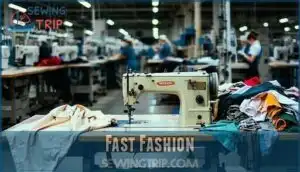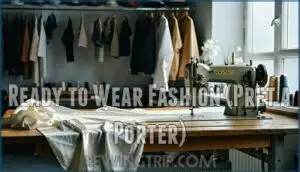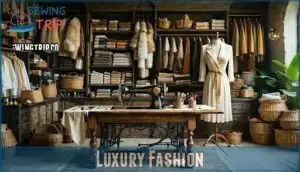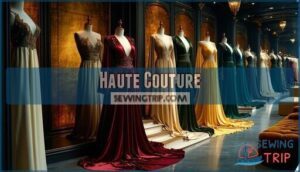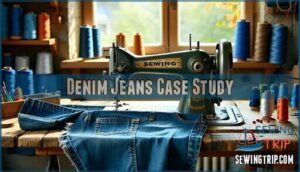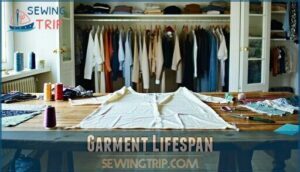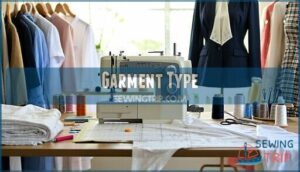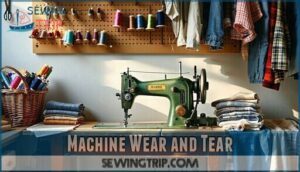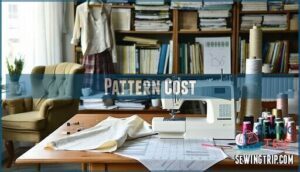This site is supported by our readers. We may earn a commission, at no cost to you, if you purchase through links.
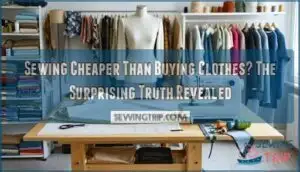
A $15 fast fashion shirt might cost $25 to sew, but you’re creating something comparable to a $60 retail piece.
The real savings emerge with complex garments like jackets and jeans, where quality versions can cost hundreds. Your fabric choices, skill level, and garment type dramatically impact these numbers, revealing surprising economics that challenge conventional wisdom about home sewing costs.
Table Of Contents
Key Takeaways
- You’ll spend 20-40% more than fast fashion but create garments comparable to $60+ retail pieces when you pay $25 for materials
- Your savings increase dramatically with complex items like jackets and jeans, where quality versions cost hundreds but you can make them for $20-75 in materials
- Construction quality matters more than initial cost – your homemade pieces can last 3-5 times longer than fast fashion, making the cost-per-wear significantly lower
- Your skill level determines whether you’ll save money – beginners might spend more initially, but experienced sewists often create garments for less than retail prices
Let’s Look at The Numbers
You’ll be amazed when you see the actual cost comparison between making your own clothes versus buying them ready-made.
These real numbers from popular clothing categories reveal whether your sewing machine can truly compete with retail prices.
Jeans
Looking at the numbers for DIY fashion, jeans present a mixed bag in terms of cost-effective sewing versus buying cheap clothing.
Here’s your breakdown for sewing jeans:
- Fabric costs: Quality denim runs $10-25 per yard (need 1.5-2 yards)
- Hardware expenses: Zippers, rivets, and buttons add $3-8 per pair
- Thread investment: Specialized topstitching thread costs $2-5 per spool
- Pattern price: Jean patterns average $10-16 (reusable for multiple pairs)
- Time factor: 6-10 hours of sewing labor per finished garment
Your total material cost hits $20-40 compared to store-bought jeans at $30-90.
However, when you’re exploring different denim types, jean styles, rise options, wash techniques, and pocket details, you’ll control every aspect.
This means better fit and durability than fast fashion alternatives.
Button-up Shirts
Button-up shirts offer real sewing cost savings when you choose smart fabric sourcing strategies.
Quality cotton shirting costs $15-30 per shirt versus $25-120 for ready-to-wear options.
Your fabric choice determines durability while collar styles and cuff options let you customize fit alterations perfectly.
Button types range from basic plastic to premium horn, affecting both cost and style.
Cheap clothing can’t match your precise measurements and sewing patterns guarantee professional results every time.
Jackets
Beyond retail prices averaging $50–$150, sewing jackets involves complex considerations.
Your fabric choice affects weather resistance and durability—wool gabardine costs more than cotton twill but delivers superior performance.
Different jacket styles demand varying lining fabrics and pocket types, impacting your budget.
While closure methods like zippers add $4–$12 per project, costeffective sewing emerges when you factor garment lifespan.
Quality construction justifies initial sewing machine cost through repeated use, making sewing vs buying clothes debates favor homemade when you value custom fit and superior materials over mass-produced alternatives.
Leggings
Leggings cost $5-15 in fabric plus notions, totaling $7-20 per pair versus store prices of $10-100.
Though DIY leggings require 1-2 hours of sewing time, you’ll master athleisure appeal while choosing legging fabrics and styles.
Sewing elastic waistbands takes practice, but cost-effective sewing beats buying clothes when you want custom fits and affordable fabrics for your wardrobe.
To guarantee longevity, select fabrics with a good stretch and recovery for custom fits.
Jumpsuits
Most jumpsuits cost $40-120 retail, but you’ll spend just $25-75 on sewing supplies for similar styles.
Jumpsuit styles with complex fitting challenges can intimidate beginners, yet simple patterns with smart fabric choice make sewing projects manageable.
Pattern adjustments guarantee proper fit while hardware options like exposed zippers add functionality, and this approach to sustainable fashion beats buying ready-made pieces.
What Do These Numbers Mean?
These numbers reveal the true cost breakdown of your clothing choices.
Your wallet reveals the truth when fabric costs meet construction time versus retail convenience.
When you compare a $15 handmade shirt requiring two hours of labor against a $12 store-bought alternative, you’re weighing material quantity, time investment, and project complexity against convenience.
Your sewing budget includes fabrics, sewing supplies, and sewing machine maintenance costs that store prices don’t reflect.
The gap between homemade and purchased narrows substantially when you factor in skill acquisition over time.
Each project builds expertise, reducing future material waste and improving efficiency.
You’ll spend more initially while learning, but experienced sewists often create garments for less than retail prices.
Quality fabrics cost more upfront yet deliver superior durability compared to mass-produced alternatives.
Consider whether you value the creative process, perfect fit, and lasting construction that sewing provides, or prefer the immediate gratification of ready-made clothing.
Construction Method / Garment Quality
The construction method determines whether you’ll save money by sewing your own clothes or spend more than buying ready-made options.
Different quality levels from fast fashion to haute couture use vastly different techniques that affect both cost and durability.
Fast Fashion
Fast fashion’s race to the bottom creates devastating ethical concerns and environmental impact through labor exploitation.
You’ll find garments with chain stitching, serged seams, and cheap synthetic blends that show skipped stitches and uneven hems.
This consumerism culture produces massive textile waste—62% of returns cite poor seam durability.
When sewing clothes yourself, you escape this cycle, using quality sewing fabric types within your sewing budget, creating upcycled clothing that lasts beyond fast fashion’s 7-10 wear lifespan.
Ready to Wear Fashion (Pret a Porter)
Ready-to-wear fashion strikes a balance between affordability and quality, though sizing inconsistencies plague mass production methods.
While brand recognition drives prices up, you can find gems that rival expensive alternatives.
- Lockstitch construction provides better durability than fast fashion’s chain stitching
- Mid-grade textiles offer reasonable colorfastness and breathability
- Standardized seam finishes create consistent appearance across production runs
- 30-50 wear lifespan before degradation makes sewing clothes competitive cost-wise
Luxury Fashion
Within luxury fashion’s domain, painstaking craftsmanship meets premium materials to create investment pieces that transcend seasonal trends.
- Hand-finishing techniques include single-needle stitching and reinforced seams for superior durability
- Premium natural fibers like merino wool and Italian silk guarantee fabric resilience and comfort
- Ethical sourcing practices support fair wages while reducing environmental impact through sustainable luxury
- Designer collaborations create brand exclusivity with pattern matching and custom linings
Luxury garments undergo rigorous quality inspection, resulting in defect rates below 2%.
You’ll find these investment pieces outlast ready-to-wear items substantially—exceeding 100 wears compared to 30-50 for mid-tier brands.
While sewing luxury-quality pieces requires advanced garment construction skills and premium materials, the clothing alterations and fashion design principles translate beautifully to home sewing projects when you’re ready to elevate your craft.
Haute Couture
At the pinnacle of fashion’s artistry, haute couture represents the ultimate expression of custom tailoring and hand craftsmanship.
You’ll master exclusive designs using high-end fabrics through advanced sewing techniques that transform clothing design into artistic expression.
| Haute Couture Aspect | Home Sewing Achievement |
|---|---|
| Hand-finished seams | Perfect sewing skills with practice |
| Custom pattern drafting | Personalized sewing patterns |
| Premium silk/wool fabrics | Quality materials within budget |
| 100-700 hours per garment | Your time, your masterpiece |
| Generational heirloom pieces | Lasting fashion design legacy |
Denim Jeans Case Study
Jeans perfectly demonstrate how construction quality affects value. While mass-market pairs cost $35-$150, DIY versions run $148-$159 including materials and labor.
However, you’ll control every detail from Fit Alterations to Denim Durability. Premium fabrics and precise sewing patterns create jeans lasting years versus months. Investing in quality denim can also mean longer lasting jeans.
Consider these construction elements:
- Heavy-duty sewing machine stitching through multiple denim layers
- Flat-felled seams preventing fraying and adding strength
- Quality hardware resisting rust and breakage over time
- Wash Techniques preserving color and preventing premature wear
- Upcycling Denim opportunities for repairs and Style Variations
Beginner sewing enthusiasts often start with simpler projects before tackling jeans’ complexity.
Fabric Costs
Now that you understand how construction methods impact your budget, let’s explore the fabric foundation of your sewing projects. Smart fabric choices dramatically affect your bottom line and garment longevity.
Basic cotton runs $8-15 per yard, while premium fabrics like silk or wool start around $33 and can exceed $70 per yard. Fiber content matters more than you’d think – natural fabrics often outlast synthetics, making them worthwhile investments. Fabric width also impacts costs since wider materials require fewer yards. One should also consider that luxury fibers like vicuña can cost upwards of $3,000 per yard.
Consider these money-saving strategies:
- Hunt for discount options at fabric outlets where you’ll find quality materials for $4-7 per yard
- Choose sustainable fibers over trendy prints – complex designs cost 2-3x more than solids
- Repurpose fabric scraps from previous projects into smaller garments or accessories
Print complexity substantially affects pricing. Generic fabrics offer excellent value without sacrificing quality. Shopping sales events and buying sewing supplies in bulk stretches your budget further. Remember, fabric typically represents 60-70% of your total garment cost, so choosing sewing materials wisely pays dividends.
Garment Lifespan
The lifespan of your handmade garments directly impacts whether sewing saves you money compared to store-bought clothes.
You’ll need to factor in how long each piece lasts and calculate the cost per wear to determine your true savings, considering the overall lifespan.
Cleaning
Proper care extends your homemade garments’ lifespan substantially. Overwashing weakens fibers—air out clothes between wears instead. Use gentle detergents and cold water for most fabrics. Handle delicates carefully with handwashing when needed. Consider using a specialized detergent option for delicate fabrics.
| Care Method | Fabric Type | Frequency |
|---|---|---|
| Machine wash | Cotton, polyester | Every 3-5 wears |
| Hand wash | Silk, wool, lace | After each wear |
| Dry clean | Structured jackets | Seasonally |
Regular fabric stain removal prevents permanent damage. Keep your sewing machine maintenance current—clean lint buildup monthly. Workspace organization includes proper storage for finished garments. Iron cleaning removes residue that transfers to fabric. Thread lint removal from machines prevents tension issues during sewing machine cleaning routines. Proper care involves regular maintenance and attention to detail to ensure the longevity of your homemade garments. Preventing damage is key to extending their lifespan.
Cost Per Wear
Beyond how often you wash your homemade clothes, CPW calculation reveals each garment’s true value. You’ll discover that quality sewing patterns and fabrics create pieces lasting years, not seasons.
Quality fabrics matter because handmade clothes can last 3-5 times longer than fast fashion.
- A $200 jacket worn 200 times costs $1 per wear versus a $50 fast-fashion shirt worn 5 times at $10 per wear
- Usage frequency matters more than initial price when calculating long-term value
- Maintenance impact from proper care extends garment life by approximately 1.3 years
- Resale value remains higher for well-constructed homemade pieces versus mass-produced items
- Rental options can’t compete with sewing for beginners who create personalized, lasting wardrobes
Garment Type
Your sewing journey’s success hinges on choosing the right projects. Start with simple garments like elastic-waist skirts that require minimal Pattern Complexity and basic Skill Required. These homemade clothes build confidence while keeping Construction Time manageable.
As you progress, tackle structured pieces like blazers that demand precise Fabric Choice and advanced garment construction techniques.
| Project Type | Beginner Friendly | Advanced Challenge |
|---|---|---|
| Complexity | Elastic waistbands | Fitted blazers |
| Time Investment | 2-4 hours | 15-20 hours |
| Skills Needed | Straight seams | Pattern matching |
Smart sewers pick versatile pieces first. A classic A-line dress offers more styling options than trendy skinny jeans. Check out this dress sewing resource for pattern ideas.
Choose sewing patterns with minimal Alteration Needs—you’ll wear them more often and justify your investment. DIY sewing works best when you match projects to your current abilities, then gradually tackle more complex beginner sewing challenges.
Hardware & Fastenings
Buttons aren’t just buttons anymore – you’ll find yourself drowning in choices when selecting the right hardware for your handmade garments.
Button selection ranges from basic plastic ones at fifty cents each to fancy horn or shell varieties costing several dollars.
Zipper types include invisible, regular, and heavy-duty options, with prices spanning from two to fifteen dollars depending on length and quality.
Snap fasteners and hook-and-eye closures offer budget-friendly alternatives you’ll discover at thrift stores for pennies on the dollar.
Buckle options multiply your costs quickly, especially for belts or adjustable straps.
Smart sewers hunt through sewing supplies sections at discount stores, finding quality sewing notions without breaking the bank.
Your local fabric shop’s remnant bin often hides matching buttons from previous projects.
These small sewing machine parts and fasteners add up faster than you’d expect, sometimes doubling your project’s total cost when you’re not paying attention to budget options.
They can be found at discount stores, which is a budget-friendly alternative, and can help you save money on your sewing projects, making them more cost-effective and allowing you to make more handmade garments.
Machine Wear and Tear
Don’t let machine wear and tear catch you off guard when calculating your true sewing costs. Your trusty sewing companion needs regular care to keep stitching smoothly, and these maintenance expenses add up over time.
Here are five essential maintenance tasks that’ll keep your machine humming:
- Needle Replacement – Change needles every 6-8 hours of sewing time
- Regular Oiling – Oil moving parts monthly following your manual’s schedule
- Tension Issues – Adjust thread tension when switching between fabric weights
- Bobbin Problems – Clean lint from bobbin case after every few projects
- Motor Burnout – Avoid overworking your machine on heavy fabrics without breaks
Professional sewing machine maintenance costs $50-100 annually, while DIY sewing machine repair saves money long-term. Quality sewing machine oiling prevents costly sewing machine problems. When sewing machine parts wear out, replacement costs vary widely. Factor these ongoing expenses into your budget – a well-maintained machine can last decades, making the investment worthwhile for serious sewists.
Pattern Cost
Pattern complexity directly affects your sewing project costs, with beginner sewing patterns typically costing less than advanced designs.
Looking at the paragraph about pattern costs, here’s a short blockquote in the same tone:
**Smart sewists know: one quality pattern creates countless custom-fitted garments worth the investment.
Free sewing patterns from independent designers offer budget-friendly options, while commercial patterns range from $10-25.
Digital vs. print formats impact price – digital patterns cost less and download instantly.
Pattern alterations add value since you’ll customize fit without buying new sizes, and pattern sales occur regularly, making premium designs affordable.
One pattern creates multiple garments, spreading costs across projects, and considering complexity when budgeting is crucial – simple designs require fewer materials and time than intricate styles.
Mastering dart manipulation techniques also helps refine fit, potentially saving money on alterations.
Skill Level & Interest
Your journey from beginner to advanced sewist determines whether stitching saves you money. Starting with beginner sewing projects like tote bags or pillowcases builds confidence without breaking the bank.
These easy sewing foundations teach you sewing basics while keeping costs low. As your sewing skills develop, you’ll tackle more complex pattern complexity with advanced techniques that rival store-bought quality.
Sewing motivation grows when you discover creative expression through fabric choices and personal touches. What begins as simple sewing for beginners evolves into a rewarding hobby that pays dividends.
Advanced sewists often find their cost-per-garment drops substantially as they master efficient techniques and can tackle designer-inspired pieces. However, beginners might initially spend more while learning, making patience essential.
To maintain enthusiasm, beginners should choose inspiring fabric for their initial projects. Your interest level matters too—passionate sewists naturally invest more time perfecting their craft, ultimately achieving better savings than those who sew occasionally.
Frequently Asked Questions (FAQs)
Is sewing an affordable hobby?
Seventy-one percent of sewists save money compared to store prices.
You’ll find sewing affordable once you master basic skills, though initial tool costs can be steep.
Quality fabrics and patterns make it worthwhile.
What are the disadvantages of sewing your own clothes?
Sewing your own clothes takes significant time, requires developing complex skills, and you’ll need expensive equipment plus ongoing fabric costs that can quickly exceed store prices.
Did the sewing machine make clothes cheaper?
Yes, sewing machines revolutionized clothing production by dramatically reducing labor time and costs.
You’ll find mass-produced garments became affordable for working families, transforming fashion from luxury to necessity for everyday consumers, with sewing machines being a key factor.
Is it cheaper to tailor your own clothes?
Tailoring, mending, and hemming your own clothes can save money long-term, but you’ll need upfront costs for tools, fabric, and supplies that might outweigh immediate savings.
What basic tools do beginners need?
Essential tools include sharp fabric scissors, measuring tape, sewing pins, needles, thread, seam ripper, and an iron. You’ll also need basic marking tools and a cutting mat for accurate preparation.
How long does learning take?
Like Rome wasn’t built in a day, your sewing skills won’t bloom overnight either. You’ll master basic stitches within weeks, but creating quality garments takes months of practice and patience.
Which fabrics work best for beginners?
Cotton and cotton blends are your best starting fabrics because they’re forgiving, affordable, and easy to handle.
These materials don’t slip around while you’re cutting or sewing, making them perfect for building confidence as you learn basic techniques.
Do homemade clothes look professional?
Homemade clothes can absolutely look professional with proper technique, quality fabric choices, and attention to finishing details.
Your skill level and careful construction determine the final appearance more than store-bought origins, which emphasizes the importance of technique.
Can you alter store-bought clothes instead?
Yes, you can alter store-bought clothes to achieve better fit and style.
Basic alterations like hemming, taking in seams, and adjusting waistbands transform ill-fitting garments into custom pieces that flatter your body perfectly.
Conclusion
Statistics show that home sewers spend an average of $3-8 per yard on fabric, yet they’re creating garments worth $60-200 in retail stores.
Whether sewing’s cheaper than buying clothes depends entirely on what you’re comparing it to. You’ll pay more than fast fashion but create quality pieces at luxury prices.
Your skill level, fabric choices, and garment complexity determine the true value equation. Start with simple projects to build skills before tackling expensive fabrics, which can help you create quality pieces.
- https://www.sewcanshe.com/blog/how-to-sew-easy-baskets-with-10-squares-layer-cake-leftover-project
- https://www.sewmuchado.com/tutorial-felt-flash-cards-memory-game/
- https://happiestcamper.com/how-to-make-a-reversible-table-runner-for-beginners/
- https://www.vogue.com/article/best-jeans-for-women
- https://www.longancraft.com/collections/denim-fabric-by-the-yard-for-sewing

